Last November Betsy went on a solo beach trip to the Gulf Coast of Florida - specifically, Fort Myers Beach. She had booked a week at the Gulfview Manor and got herself a nice beach front room with a large screened patio. She thoroughly enjoyed the stay and made plans to return the following year. Only this time she would have company - yours truly.
I am not much of a beach person although I am starting to convert. I loved the wild beaches we visited this summer in Michigan.
Although worlds apart from the wild and untamed beaches of Michigan, Florida Beaches do have alluring qualities - as millions of visitors and residents will attest.
During our initial planning for this trip, we talked about flying down and then renting a car. But after looking at the costs and limitations on what we could travel with we decided to drive. That way we could take the bikes as well as the camping gear and all the required beach paraphernalia.

Two days and 1200 miles to get from snow covered West Virginia to warm and balmy southwest Florida.
I am not used to the grinding boredom of interstate driving but I was able to keep from going nutso by listening to NPR most of the time. Of course the "news" was mostly about the ACA fiasco and got old real fast.
We did hear a couple of interesting reports on the radio, one was on NPR's "Here and Now".
We already know pedestrians routinely get run over by motorists.
Cyclists do as well. This report brought to light some very scary facts about cycling deaths caused by motorists:
Daniel Duane, contributing editor for Men’s Journal, recently posed a provocative question in the New York Times: Is it okay to kill cyclists? His answer: An even more provocative “yes.”
Duane cites statistics to claim that even as cities work to create new bike lanes, laws are stuck in the past. Drivers are rarely punished for hitting cyclists, even when the drivers are at fault.
“If you kill a cyclist, if you’re driving a car and you run over a cyclist, unless you are blatantly drunk enough for somebody to give you a breathalyzer test, or flee the scene, your chances of being prosecuted are virtually none. This is true, believe it or not, even if you’ve clearly run a stop sign, or even a stop light, or clearly been speeding,” Duane tells Here & Now’s Robin Young.
... the San Francisco Police Department had never charged a driver in the case of a cycling fatality without clear evidence of DUIs, drunk driving, or hit and run.
... a 2011 story when a man drove into a 49-year-old cyclist from behind on a road just outside Seattle, ran over him, killed him, and the police issued an unsafe lane change citation.Source: NPR Read the full transcript
While surfing the radio bands I happened on a call-in show in progress. The two talk DJ's were giving a women a quiz of some kind.
She was tasked with defining what "abolitionist" meant.
She hemmed and hawed and kept saying the word over and over again.
Finally she said: "Gosh, guys - I'm 40 years old. Do you know how long it's been since I've been in school?"
The DJs encouraged her to take a stab at it.
Finally she said: "Explorer"?
Betsy and I just looked at each other in disbelief.
OK next challenge!
One of the DJs said. "Name a country that starts with 'C'". After a slight hesitation she blurted out "Sicily!".
She was then informed "Sicily!" started with and S not a C and then one of the DJs realized it was not a country either.
He them informed her it was an island owned by Spain.
Is it just Americans who are idiots or is this affliction world wide? Brother!
Well, those were the highlight of out radio recreation.
We finally arrived at our destination around 3:00, checked in, unloaded, chilled with a beer and then headed to the beach.
Saturday November the 16th

This is the back of the building we are staying in. You can see the van with bikes hanging off the back. Up two floors is our spacious, screened in balcony.

There were some interesting clouds moving about that afternoon which were adding some drama to the skyscape.
As you can see the beach is wide and the sand fine and white. The warm water is shallow and you can walk out quite a ways and still only be waist deep.

There are still a few small places left but most have been replaced by multi-story rentals.

Betsy much anticipated and much enjoyed our first stroll along the beach. The first of many which we will both take during the coming week.
Sunday November the 17th

Our first morning here at the beach and we had a nice stroll around 7am.
They have sand sculpture competitions here and people really get into it.



We love seeing all the birds on the beach! Here we see royal terns.

There were lots of Sandwich terns which we were not used to seeing.
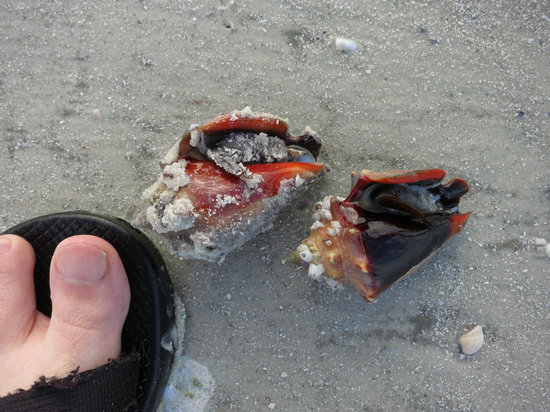
Betsy told me about all the conch shells she had seen last year. And at low tide you can see plenty of them.
Growing up we had one of the big conch shells which can be used as a horn. As you can see these are quite small.


This is what the conch we had as kids looked like.
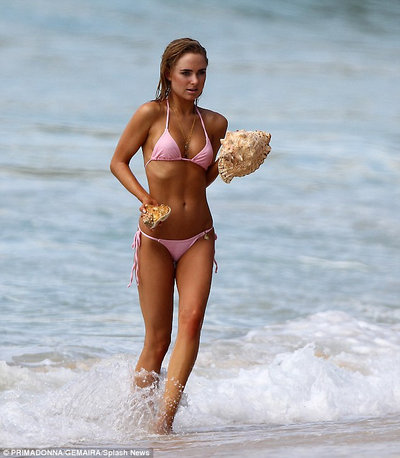
Conch collecting is a popular pastime at the beach.

Every conch, and there were 100s, had one of these creatures living in them.

We saw a few sea stars as well.
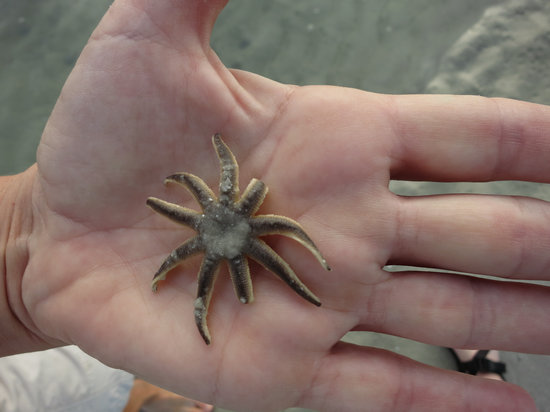
Last year Betsy saw sea stars nearly a foot wide. Not so this year.
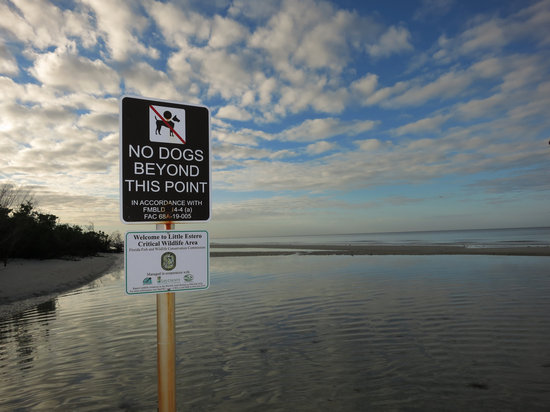
This sign was near a tiny fragment of mangrove that was somehow spared the bulldozer.

This will give you an idea of the typical water level at high tide.
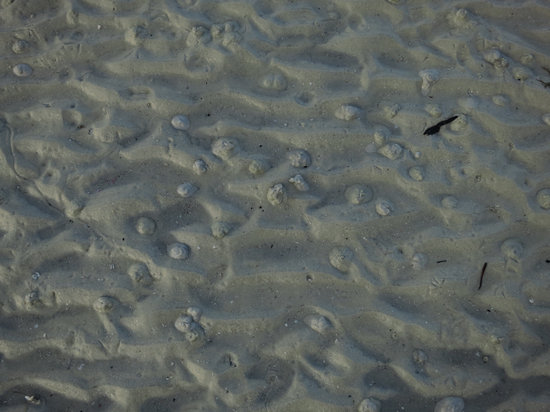
There were millions of these tiny sand towers.
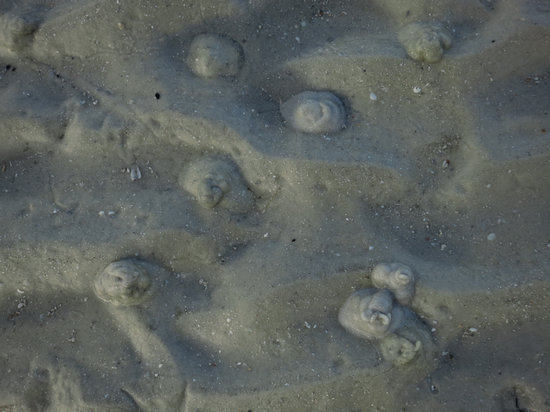

I think this is a mangrove "seed".
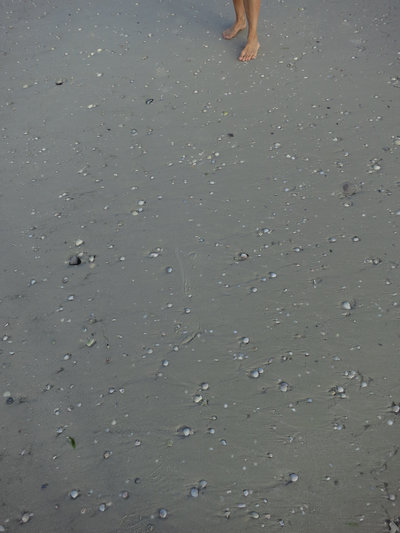
Future limestone.
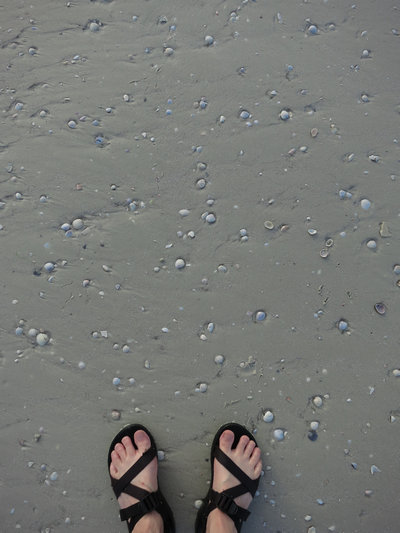
The shells of many animals, those that live either in the sea or in freshwater, consist of calcium carbonate (calcite and aragonite). When the animals die, their shells are left on the ocean floor, lake bottom or river bed where they may accumulate into thick deposits.
Source: Topeka Gem & Mineral Society
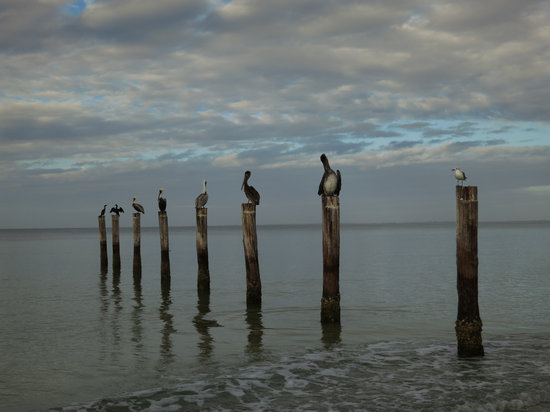
Sun bathing is popular at the beach.
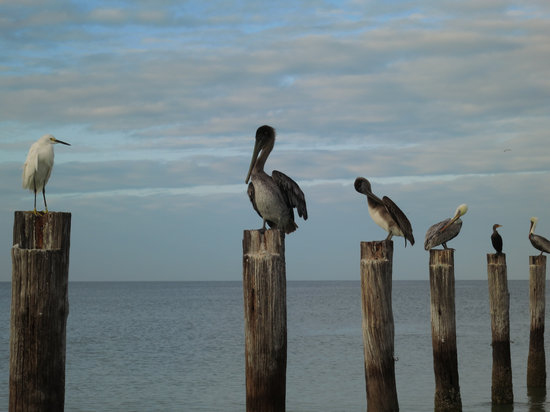
So is preening.
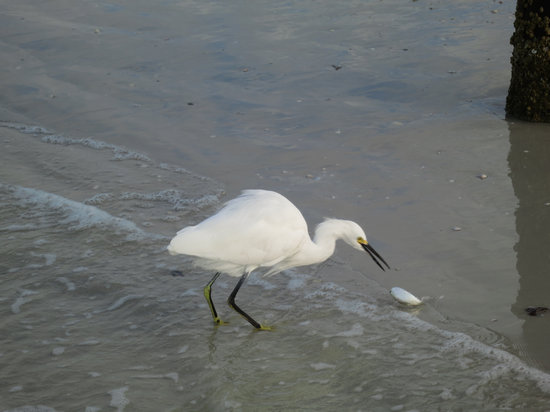
And fishing as well.

This snowy egret goes in for seconds.
~~~~~~~~~~~~~~~~~~~~~~~
Later in the afternoon Betsy and I went out for groceries and decided to stop and have a look at the Matanzas Pass Preserve
The Matanzas Pass(Wilderness)Preserve was dedicated on January 20, 1979 as a sanctuary for native plants and animals and as a learning resource for the Lee County Community. Matanzas, which contains one of the last maritime oak hammocks in the area, was one of the first four-wetland eco-systems to be found in Lee County.
In 1974, Fort Myers Beach resident and nature photographer John Dunning, purchased the property from the Martha Redd estate and then donated 22 acres to The Nature Conservancy and offered to sell them the remaining acres. In 1994, the property was donated to Lee County by The Nature Conservancy at which time the word Wilderness was removed from the name of the Preserve. The Friends of Matanzas Pass Preserve has since been formed to help protect and preserve the natural habitat of this unique natural environment on Fort Myers Beach.
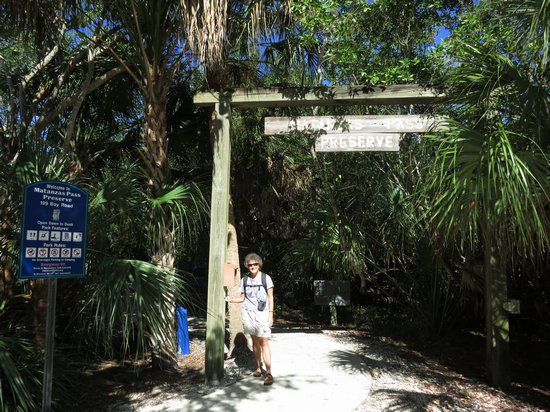
Of the nearly 4000 acres which comprise Estero Island there is not much which remains of the orginal vegetation. But the Matanzas Pass Preserve will give you a feel for what it must have been like before most of the island was bull-dozed and built up.
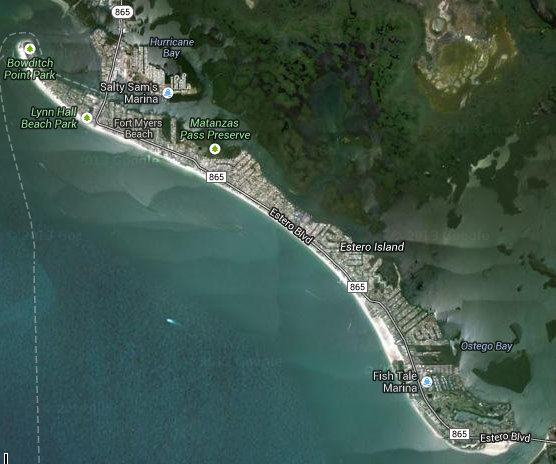
The mangrove swamps and Sabal Palm and Oak forests are now mostly gone from Estero Island.
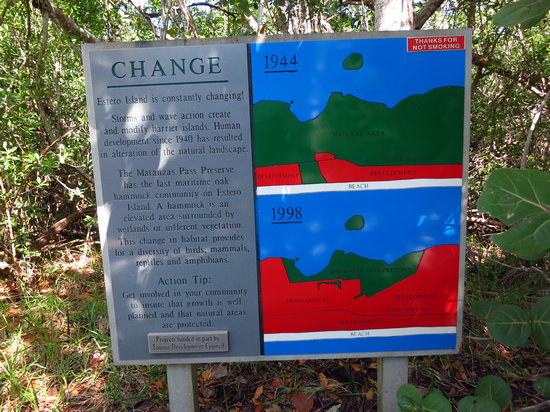
Note the sign says "1998". That was 15 years ago.
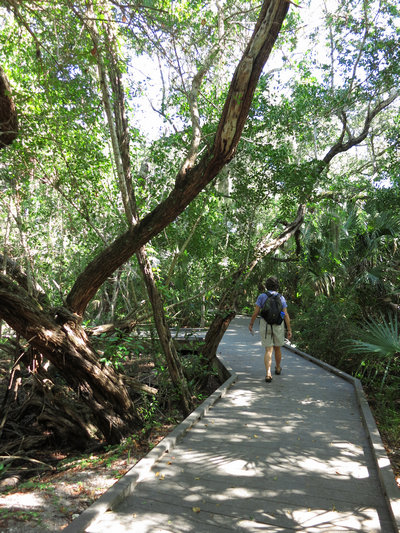
Matanzas Pass Preserve has a combination of board walks and earthen trails.
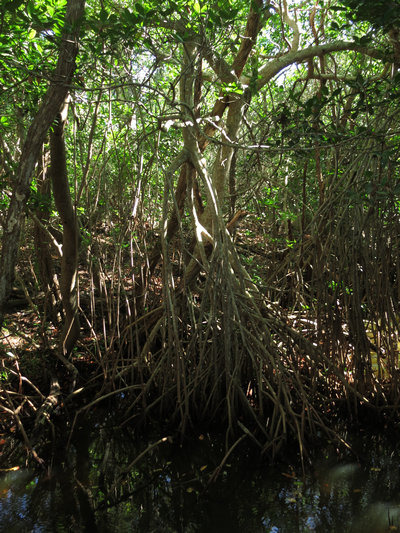
From the boardwalk we got a good look at the amazing stilt root systems of the mangrove trees. Only a complex of roots like this could keep these trees intact when the hurricanes sweep the area.
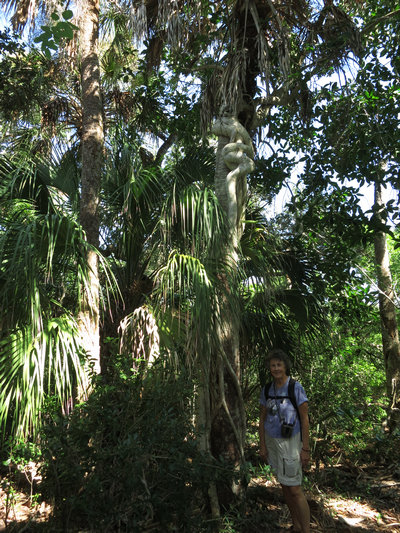
Next to and directly over Betsy's head you can see the twining stem of a Strangler fig of which there are many species.
They all share a common "strangling" growth habit that is found in many tropical forest species, particularly of the genus Ficus. This growth habit is an adaptation for growing in dark forests where the competition for light is intense. These plants begin life as epiphytes, when their seeds, often bird-dispersed, germinate in crevices atop other trees. These seedlings grow their roots downward and envelop the host tree while also growing upward to reach into the sunlight zone above the canopy.
An original support tree can sometimes die, so that the strangler fig becomes a "columnar tree" with a hollow central core.
Source: WikiPedia
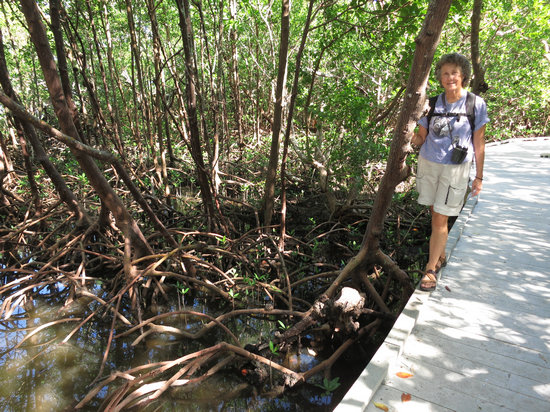
It is easy to see how much these roots of the mangrove would stabilze the soil along the shorelines.
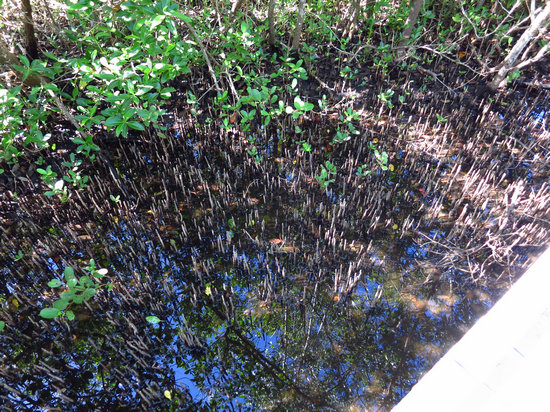
The soda straw like structures sticking out of the mud are "pneumatophores" or aerial roots.
Breathing Roots
An aerial root may be defined as a root which, for part of the day at least, is exposed to the air. The mangrove mud is rather anaerobic (oxygen poor) and unstable and different plants have root adaptations to cope with these conditions.Pneumatophores
Pneumatophores are erect roots that are some form of upward appendage or extension of the underground root system. Because these roots are exposed at least part of the day and not submerged underwater, the root system can obtain oxygen in an otherwise anaerobic substrate.Source: Copyright 2001 Raffles Museum of Biodiversity Research
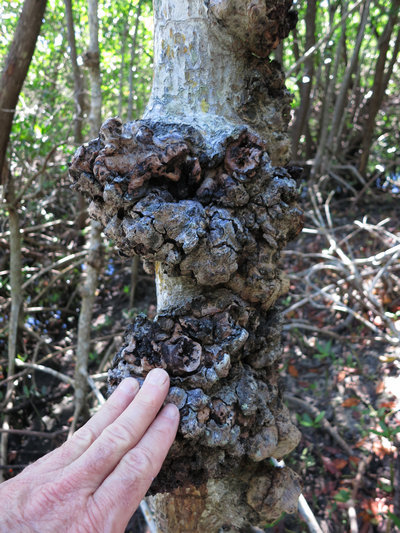
Many of the mangroves had these interesting looking growths on the the stems.
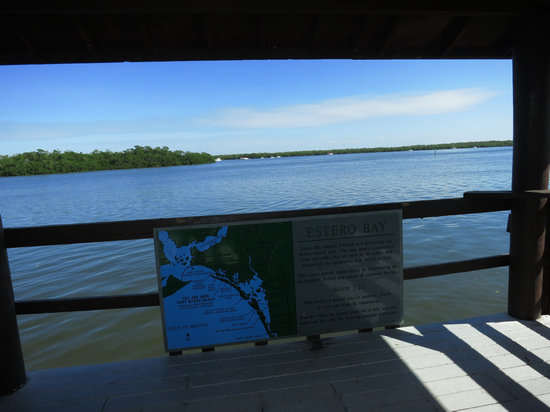
The trail led us to some welcome shade and a nice view of Estero Bay.
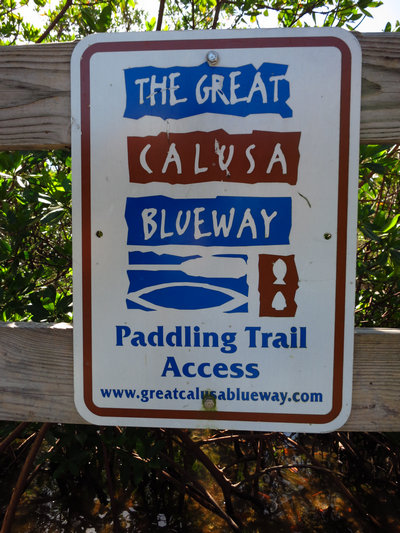
We did not bring our 'yaks on this trip. Maybe next time.
The Great Calusa Blueway Paddling Trail is a 190-mile marked canoe and kayak trail that meanders through the coastal waters and inland tributaries of Lee County, Florida.

A look back at the shelter from the boat canoe launch area.
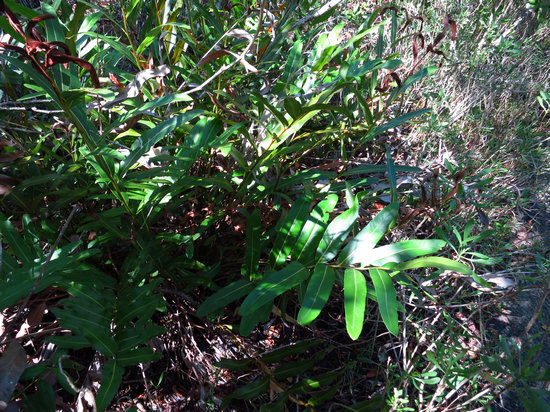
YIPPEE! A fern!
I was not familiar with this species so I consulted with Pittsburgh Joan, a fellow fern freak. Here is what she had to say:
The fern is Acrostichum danaeifolium (or possibly A. aureum if the fertile pinnae are only distal on the frond - this species is found more locally in coastal mangrove swamps along the Gulf coast of FL). Common name is leather fern because of the texture and look of the fertile pinnae. It is a magnificent genus and I loved seeing it for the first time on Tobago. Nice find!!
The pattern of bearing sporangia spread all over the abaxial side and without pattern is known as "acrostichoid" and thus, the name of the fern. The Christmas fern up here is Polystichum acrostichoides for the same pattern of the sporangia.
Source: Joan Eiger Gottlieb
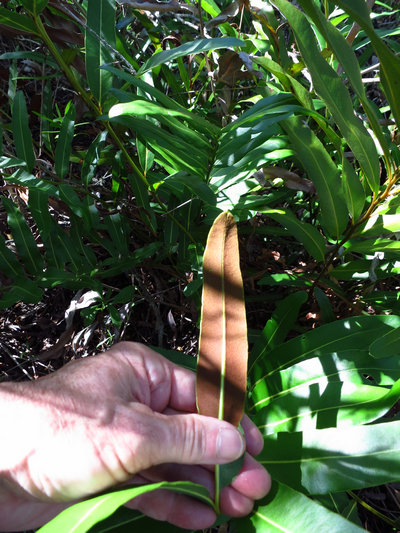
Here we see the acrostichoid sorus Joan refers to above.
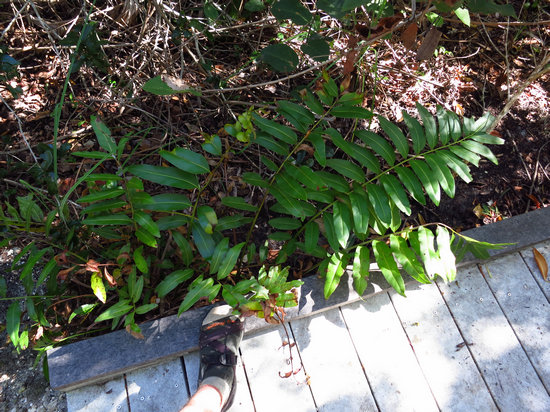
This will give you an idea of the size of this particualar specimen.
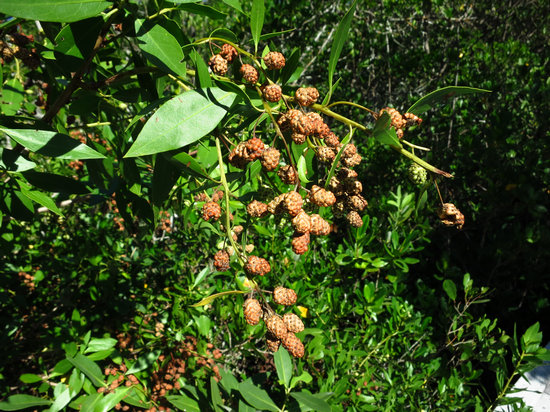
I have to figure out what tree produced these fruits. To me they looked like mulberries. But they were not.
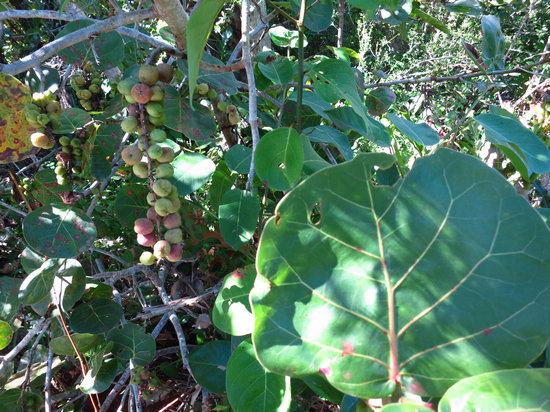
Seagrape! What a cool tree.
Coccoloba uvifera is a species of flowering plant in the buckwheat family, Polygonaceae, that is native to coastal beaches throughout tropical America and the Caribbean, including southern Florida, the Bahamas, Barbados, Antigua and Bermuda. Common names include Seagrape and Baygrape.
In late summer it bears green fruit, about 2 cm (0.79 in) diameter, in large grape-like clusters. The fruit gradually ripen to a purplish color. Each contains a large pit that constitutes most of the volume of the fruit.
Coccoloba uvifera is wind resistant, moderately tolerant of shade, and highly tolerant of salt, so it is often planted to stabilize beach edges; it is also planted as an ornamental shrub. The fruit is very tasty, and can be used for jam or eaten directly from the tree.Source: WikiPedia

This is a roosting box for bats. I am not sure where they would naturally roost here in Florida. Perhaps in the crevices of palm leaf stems where the stems meet the trunk.
Florida is home to thirteen species of bats that are either year round or seasonal residents. All thirteen species are insectivorous. Some form colonies and some roost alone. There are also seven species of bats that have, on occasion, been found in Florida but they do not normally live here. These are referred to as accidental species. Three are from more northern climates and also eat insects. Four are from more tropical regions and feed on nectar, pollen and fruit. The latter have only been found in south Florida and the Florida Keys.
Source: © 2006 Florida Bat Conservancy
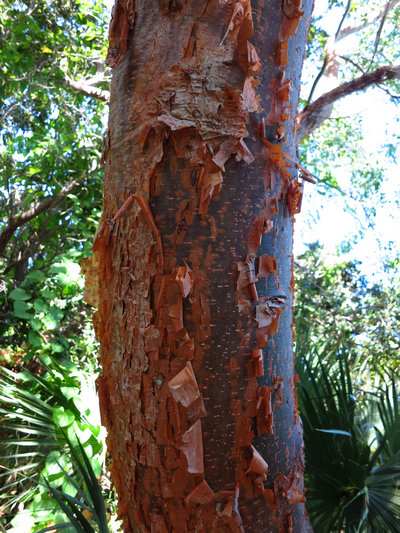
Gumbo-limbo! The beautiful tree with the funny name. It is also sometimes called "Tourist Tree" because of the reddish, peeling bark.
Native from Central America and Mexico through the West Indies, the gumbo limbo tree is also an important component of South Florida hammock habitats and an important landscape plant. The name 'gumbo limbo' seems to have its origin in African American heritage and yes, it's also linked to the thick soup we call 'gumbo': soup that is made thicker and somewhat sticky by the addition of okra.
The name is also linked to the thick, sticky mud called 'gumbo' of the Mississippi Delta and, of course, to chewing gum. So what is sticky about the gumbo limbo tree? Its sap. The word 'limbo' doesn't come from the English word referring to a place between heaven and hell, but apparently from the African Bantu language. The name 'gumbo limbo' is a reference to the sticky quality of the tree sap that made it useful in catching birds.
UoF Lee County Extension has an excellent brochure with nice photos of the Gumbo-limbo tree. You can download it here.

I had forgotten this shrub was native down here. It is American Beautyberry (Callicarpa americana). I have a specimen of it at home. It is marginally hardy and kills back most winters but always resprouts. The birds love the fruits.

Boy, did we get lucky. Joining us on our walk here in Matanzas Pass Preserve is this Gopher tortoise.
The gopher tortoise (Gopherus polyphemus) is a species of the Gopherus genus native to the southeastern United States. The gopher tortoise is seen as a keystone species because it digs burrows that provide shelter for 360 other animal species. They are threatened by predation and habitat destruction.
The gopher tortoise is a representative of the genus Gopherus, which contains the only tortoises native to North America. This species of gopher tortoise is the state reptile of Georgia and the state tortoise of Florida.
Source: WikiPedia
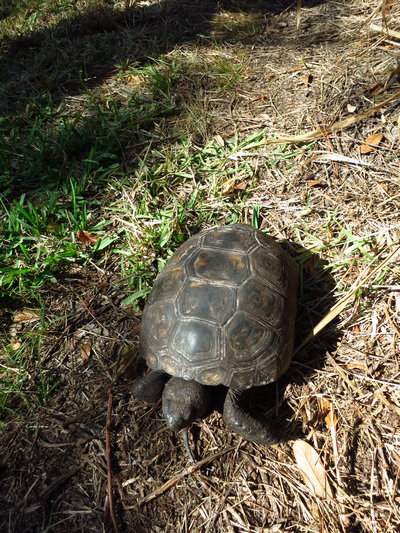
This critter was all business as it zipped down the trail in search of a snack.

We left it busily munching away at anything green it could chomp down on.

We got back from out walk hot and sweaty but that didn't last long once we hit the water.
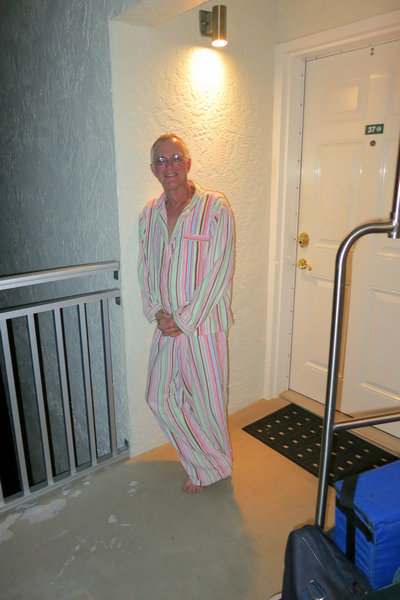
Yes, it's true - I am quite the Fashionista and here I am as living proof. While sporting the latest in beach casual wear our newly arrived next door neighbors from Ontario insisted on snapping this shot.
No doubt we will soon see this ensemble in all the Canadian fashion mags.
Monday November the 18th
We have been taking nice walks every morning around 7:00. At that time it has been close to low tide and there are lots of exposed shells, conchs and feeding, basking and preening birds to enjoy.
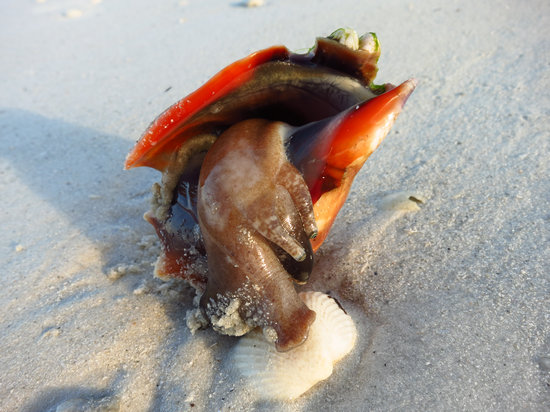
We saw many more of the these interesting sea snails on our walk. Betsy and I were wondering why we did not see any of the birds feeding on them.
Technically the occupants are called marine gastropod molluscs.
WikiPedia tells us more:
Conch is a common name that is applied to a number of different medium to large-sized sea snails or their shells. The term generally applies to large sea snails whose shell has a high spire and a noticeable siphonal canal (in other words, the shell comes to a point at both ends).
True conches are marine gastropod molluscs in the family Strombidae, specifically in the genus Strombus and other closely related genera such as Eustrombus.
Many species also are often called "conch", but are not in the family Strombidae, including Melongena species (family Melongenidae), and the horse conch Pleuroploca gigantea (family Fasciolariidae). They also include the sacred chank or more correctly shankha shell (Turbinella pyrum) and other Turbinella species in the family Turbinellidae.
Source: WikiPedia
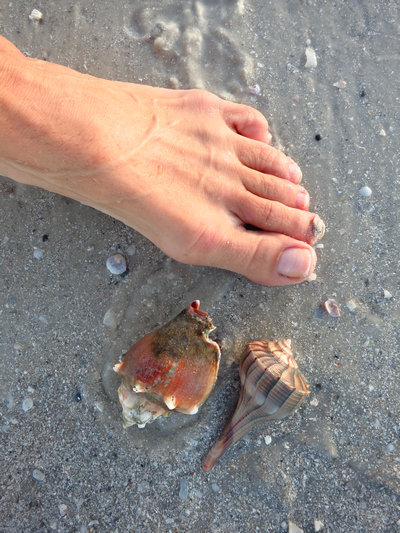
A conch and a whelk.
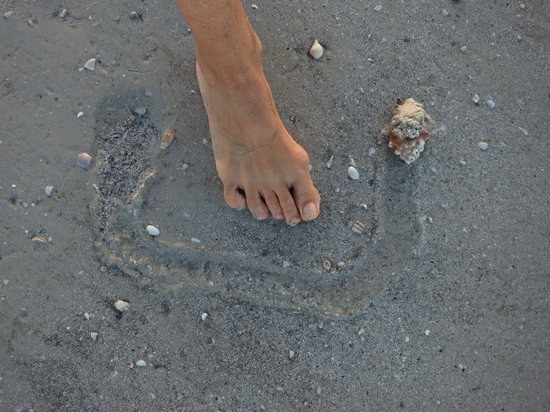
Yes, the sea snails do move around a bit.
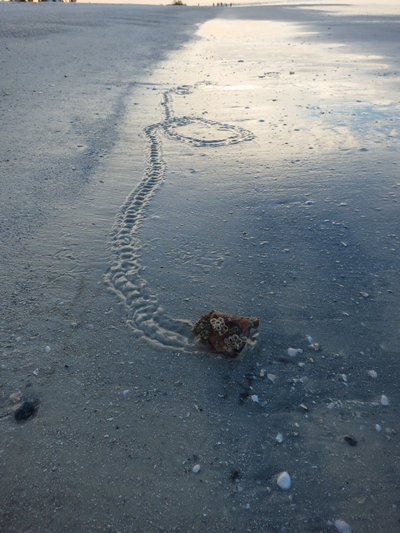
This one took quite a trip!
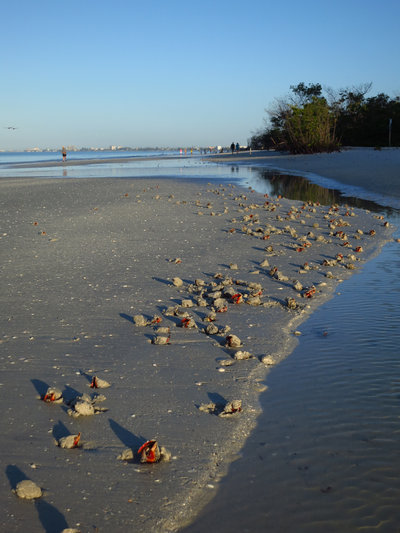
We have been seeing hundreds of conchs at this same location every morning.
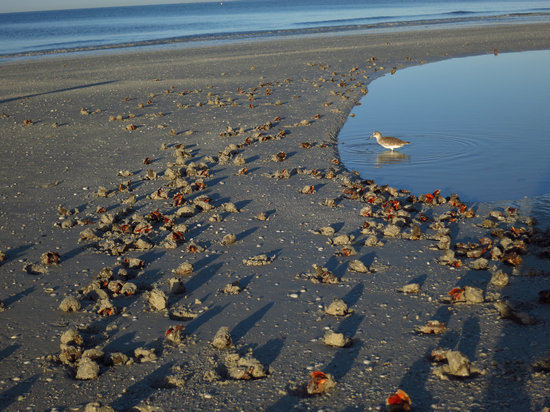
That is a Willet
Willets are large, stocky shorebirds with long legs and thick, straight bills considerably longer than the head. Their wings are broader and rounder than those of many shorebirds and the tail is short and squared off at the base.
Willets are often seen alone. They walk deliberately, pausing to probe for crabs, worms and other prey in sand and mudflats, or to pick at insects and mollusks. When startled, they react with a piercing call, often opening their wings and running rather than taking flight.
Source: © 2011 Cornell University
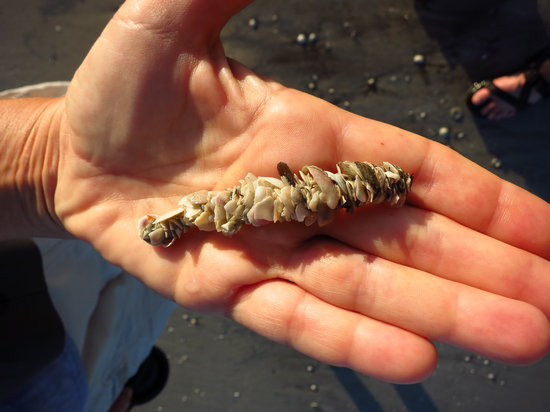
When we first saw this we thought it was someone's shell bracelet. But, on closer inspection the center was a thick, hollow tube. I have tried to find out what this thing is but so far I have had no luck.
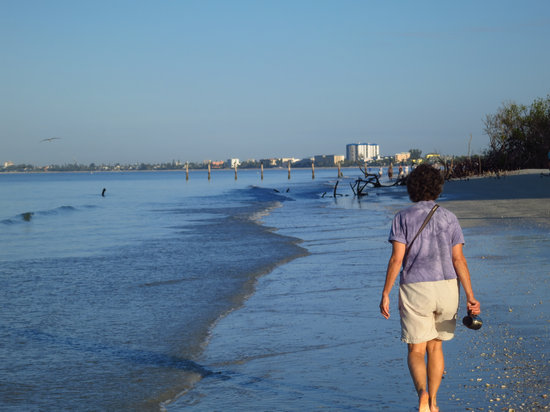
Nothing like an early morning stroll on the beach.
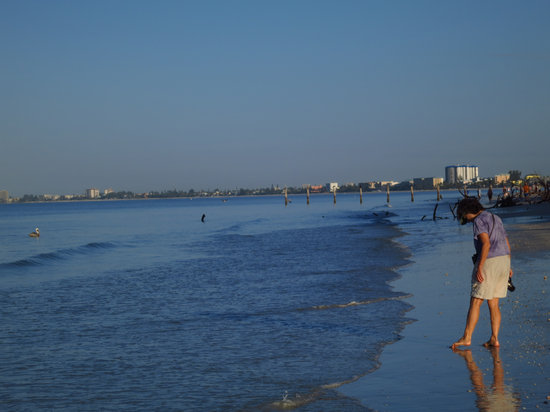
Betsy always keeps a keen eye out for hidden treasures.
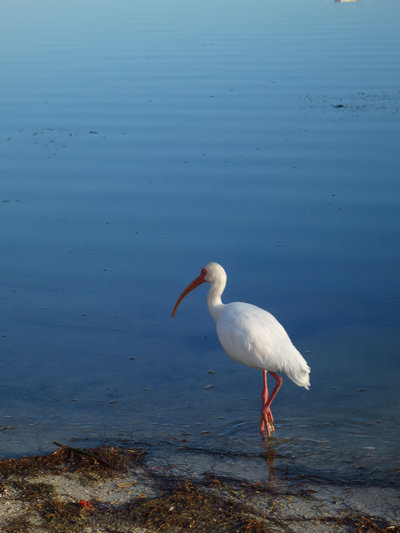
This is a White Ibis. We have seen lots of these both at the beach and along the road ways.
This distinctive wading bird is commonly found in the coastal marshes and wetlands of tropical North and Central America. Often found in large flocks, the White Ibis is easily identified by its white plumage and long curved red bill.
With long red legs, all white plumage, red face, and long decurved red bill, an adult White Ibis in breeding plumage is easily identified. Black wing tips are especially evident in flight. In flight, the outstretched wings measure three feet across, and have small yet obvious patches of black at the tips. Adults stand about two feet tall, and weigh about two pounds.

This beauty is a Reddish Egret.
An inhabitant of the saltwater marshes and lagoons skirting the Gulf of Mexico, the Reddish Egret is the rarest and least well-known of the North American herons. Unlike slower-moving hunters in its family, this egret is notable for its spirited foraging techniques.
These medium-sized herons weigh one pound, and grow to a height of more than two feet, with a wingspan of four feet. Reddish Egrets have two distinctly different color forms: white and dark.

We have seen lots of these Snowy Egrets.
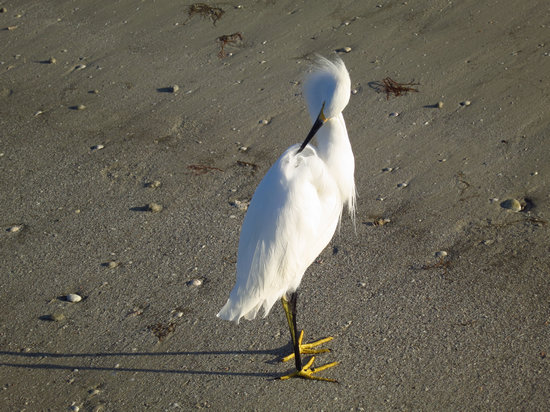
The exquisite Snowy Egret is one of North America's most familiar herons, having staged a rapid comeback after protective legislation was enacted in the early 1900s. Found throughout the Western Hemisphere, these wading birds are delicately built, with snowy white feathers, black legs, and bright yellow feet, which they use to actively stir up prey in the shallow waters of ponds and marshes.
This slender, medium-sized heron has white plumage, a slim black bill, long black legs, and vivid yellow feet. It stands about two feet tall, weighs 13 ounces, and has a three-foot wingspan. Males are slightly larger than females.
Betsy spotted a Forsters Tern this morning and that is a new one for her list.
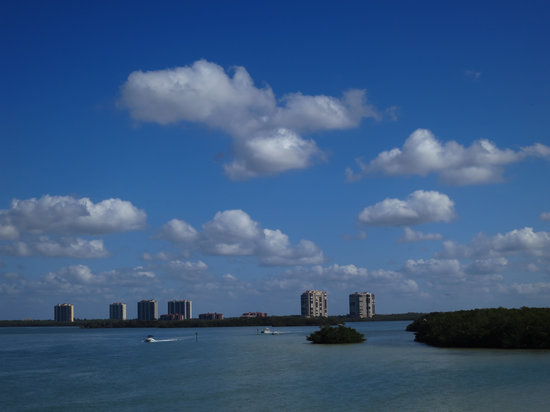
While Betsy enjoyed some quiet time, I took a bike ride down the coast. This shot was taken from near Lovers Key State Park and looks east across Estero Bay.
Unfortunately my ride was cut short by a cranky knee that swelled up like a balloon.
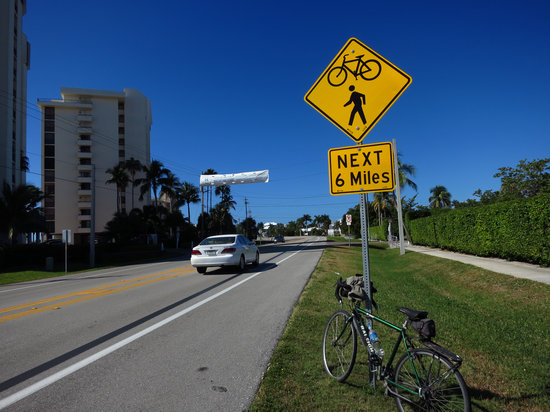
As I peddled back to the apartment I stopped to snap shots of these signs. I wish they were everywhere.
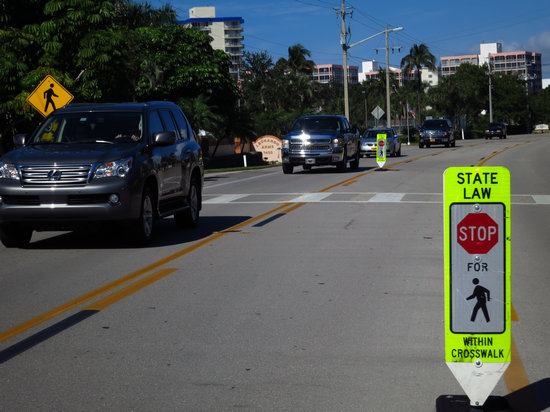
I recently learned we are getting signs like this installed in downtown Morgantown. Maybe that will help limit the number of pedestrian fatalities.

Meet "Briz and Lady".
According to their web site: "Briz and Lady is a unique and exciting acoustic duo." Yawn...
As Betsy said - they were mildly entertaining.
This shot was taken at "Pinchers Crab Shack" which is just a short walk down the beach from where we are staying. We had dinner there. They specialize in over priced, average food.
As you can see, the sunsets here can be quite dramatic. A bonus for staying on the gulf side.
Tuesday November the 19th
Betsy and I were both up by 6:00 so as to get an early start for our visit to Lovers Key State Park. The park entrance for bikes and walkers is just 2 miles down the road from where we are staying. When we arrived shortly after 7:00 it was already in the mid 70s and quite muggy. Not that we complained. We knew what the weather back home was doing.
And what exactly is a "key"? WikiPedia helps us out:
A cay , also spelled caye or key, is a small, low-elevation, sandy island formed on the surface of a coral reef. Cays occur in tropical environments throughout the Pacific, Atlantic and Indian Oceans (including in the Caribbean and on the Great Barrier Reef and Belize Barrier Reef), where they can provide habitable and agricultural land for hundreds of thousands of people. Their surrounding reef ecosystems also provide food and building materials for island inhabitants.
Source: WikiPedia
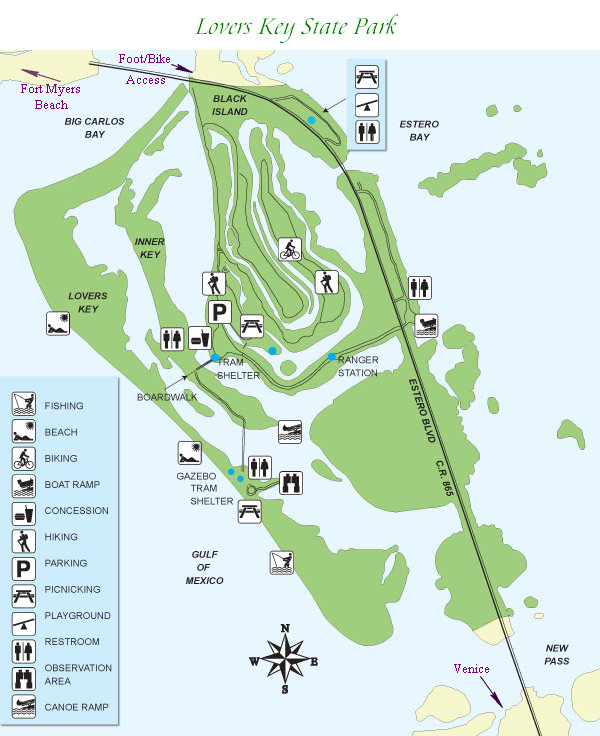
A bit of park history:
In the early 1900s the islands were accessible only by boat. It was said that only lovers made the effort to get to this romantic island, thus the name Lovers Key. A road to the island was built in 1965. Local legend hints that Black Island got its name from Black Augustus, a pirate who had been captured by authorities, and later escaped, making this island his home for the remainder of his life.
Fish camps were located on Black Island from the early 1900s until the late 1950s. Then, in the 1960s and 1970s, the four barrier islands were slated for development. Preparations for development damaged the islands. Mangrove swamps were altered to uplands by dredging a canal through Black Island.
In 1983, the state acquired the islands and in 1996, merged with adjacent Carl E. Johnson County Park to become Lovers Key Carl E. Johnson State Park.
A bit more from the Park web site:
For years, Lovers Key was accessible only by boat and it was said that only lovers traveled to the island to enjoy its remote and solitary beach. Today, it is one of four barrier islands that make up this state park.
A haven for wildlife, the islands and their waters are home to West Indian manatees, bottlenose dolphins, roseate spoonbills, marsh rabbits, and bald eagles. The two mile long beach is accessible by boardwalk or tram and is popular for shelling, swimming, picnicking, and sunbathing.
Black Island has over five miles of multiuse trails for hiking and bicycling. Anglers and boaters can launch their vessels from the park's boat ramp. The park's concession offers kayak tours, as well as bicycle, canoe and kayak rentals.
Here is a hiking trail map:

This park consists of Lovers Key and three other barrier islands — Black Island, Inner and Long Key. You can clearly see the canals which were dredged in preparation for a resort style development.
NOTE: the orange arrow bottom right points to "hill". This slight rise in elevation was created when fill material from dredging was deposited here.
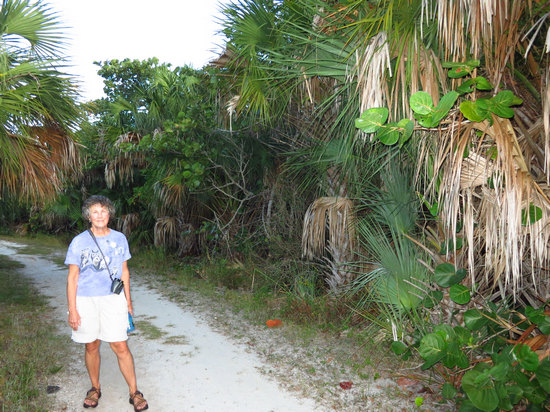
A typical section of pathway through the hammock of Lovers Key State Park.
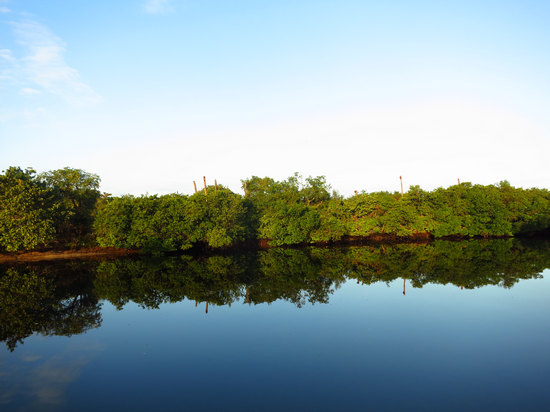
This is looking across one of the canals which our path followed. The canals are now marked with floating mile markers for the water trail users.
Note the snapped off palms on the far side. It gets windy down here when a hurricane roars through.
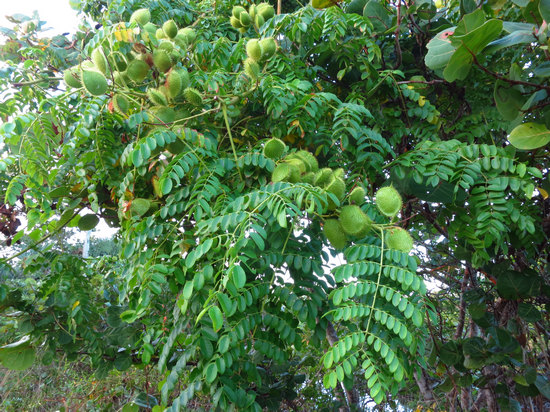
One of the fun things about exploring this maritime hammock is all the interesting plants which were new to us. And that includes most of them.
This strange looking tree is Grey Nicker Bean, AKA: Natures Barbed Wire. The leaves which reminded me of Black Locust were a tip-off this tree is also a legume.
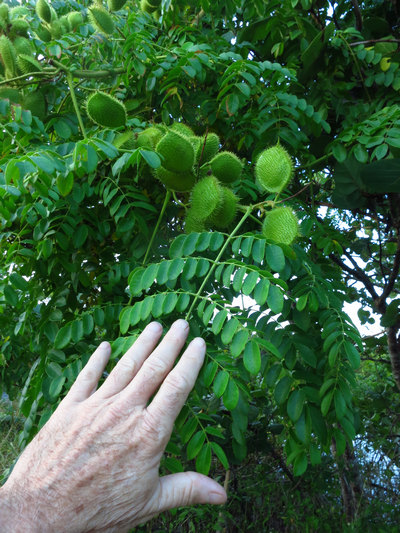
A closer look showing the relative size of the leaves and seed pods.
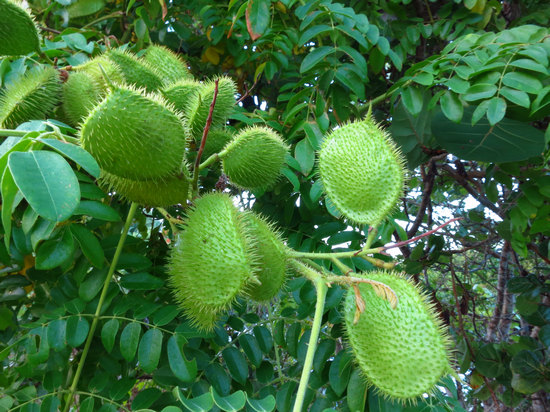
These as yet unripened pods contain the Nickernuts.
The spiney seed pods and thorny branches would certainly "nick" anyone who was careless. But the origin of the name is acutally from the Dutch "nikker" which means clay marble. This refers to the nickernuts inside the pod.
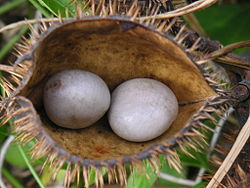
Photo: WikiPedia
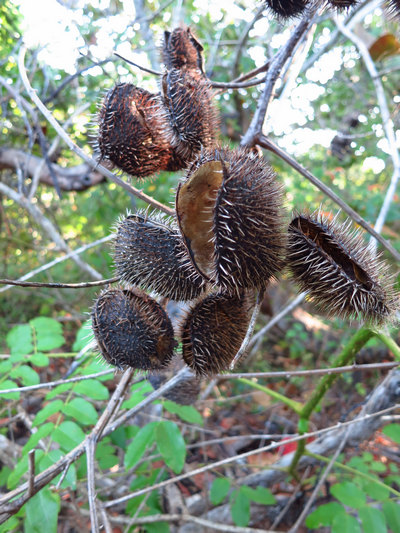
Opened and empty Nickernut pods. Interesting plant.
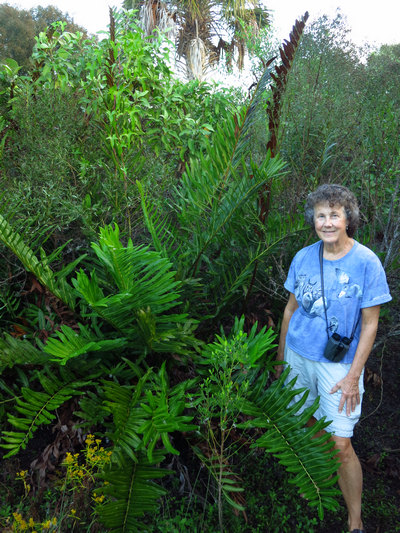
Do you remember the fern we saw at Matanzas Pass Preserve? Well, here it is again. This specimen of the so called Giant Leather Fern (Acrostichum danaeifolium) was indeed giant! Note the erect, tall brown frond just to the left of Betsy. That is the fertile (spore bearing) frond with the afore mentioned acrostichoid sorus. Way cool...

Although we did not see any Gopher Tortoises here, we did see signs for/of them.
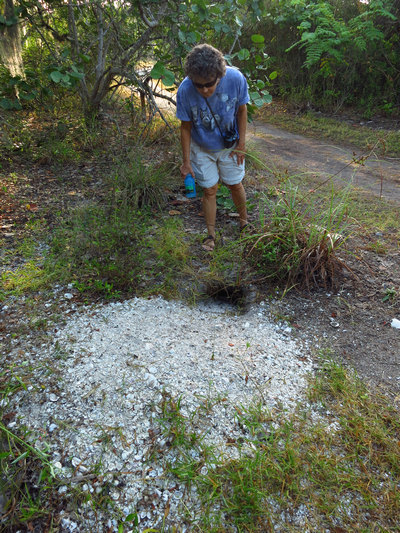
I sure wish we would have seen a tortoise sticking its head out of this burrow. Note that most of the diggings are shells and shell fragments
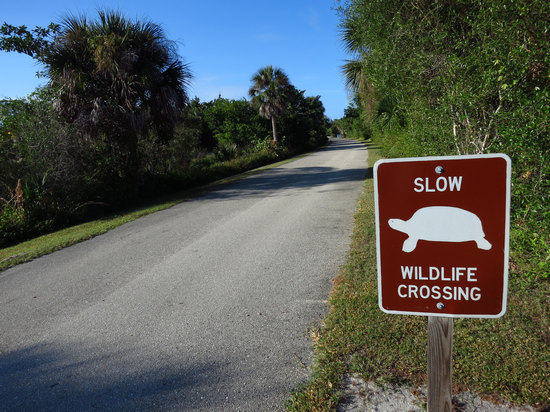
The third sign of Gopher tortoises was along the main road to the park visitors center.
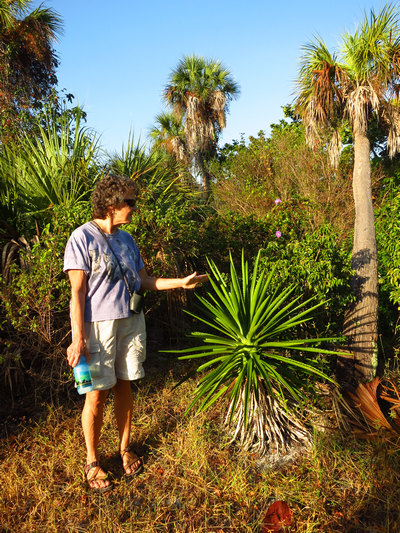
This I did not expect to see. I initially assumed it was non-native and planted here. Not so. This is Spanish Bayonet (Yucca aloifolia)
According to Floridata: "Spanish bayonet is native to coastal areas, including sand dunes, shell mounds and shorelines, from North Carolina to Mexico and in the West Indies. It is widely cultivated and naturalized throughout much of the southern US."
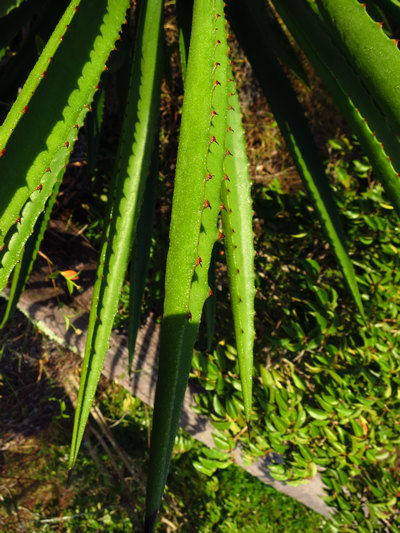
The Double Whammy! Stiff, needle sharp tips and a saw like edge. Ouch...
Stephen H. Brown, Horticulture Agent and Kim Cooprider, Master Gardener of the Lee County Extension, Fort Myers, Florida have put together this excellent article on the Spanish Bayonet.
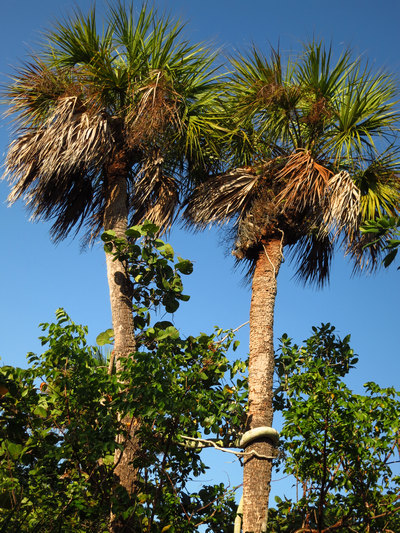
This strangler fig seems to have decided to use both of these palms to achieve its goal - pushing roots to the ground.
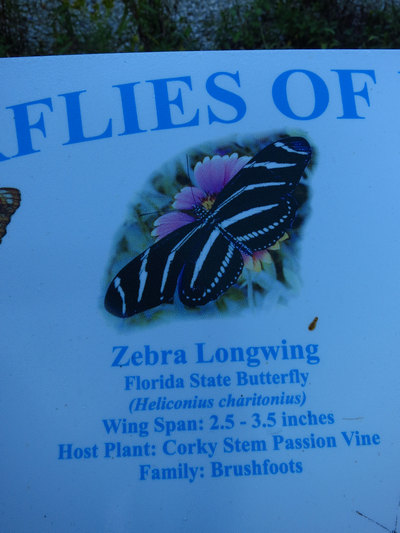
When we arrived at the butterfly garden we saw many more of the same butterfly species we had seen since our arrival. Now the mystery was solved as to what species it was.
Unlike what I am used to seeing, these butterflies had a rhythmic, almost mechanical flight pattern.
After our warm and sweaty hike we headed back to the beach to cool off and relax.
That evening we had another nice sunset.

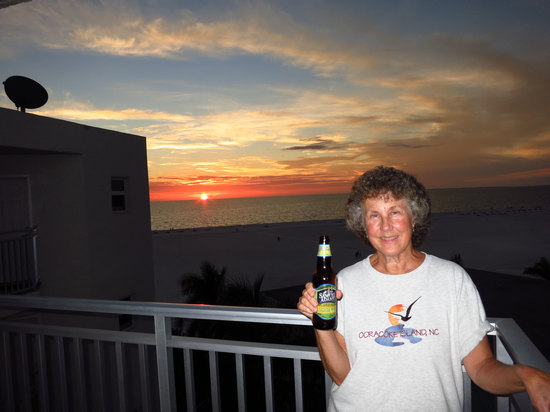
Cheers!
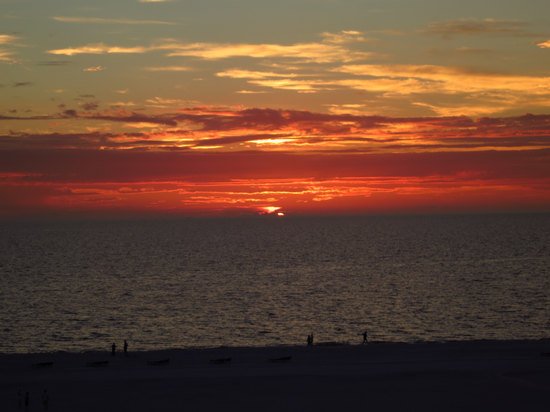
And so ends another day on the Gulf Coast of Southwest Florida.
The Wrap-Up
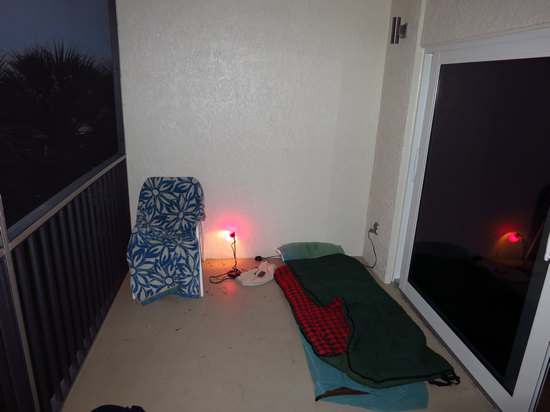
Warm days and warm nights. Nice for being outside whether awake or asleep. And so this is my bedroom - the balcony. Or, as they call them down here in Florida - "lanai". With the balmy nights, bright moon on the water and the sound of the waves I could not bear to sleep inside. So I did not.
Check out the "bed-roll": a used Therm-a-Rest mattress from Goodwill and a "vintage" Coleman sleeping bag dating from the late 70s/early 80s. I was looking for a bag with a 100% cotton shell and liner. I found this one on Craig's list in the original box for 15 bucks. And - free delivery!
The young woman who was selling it lived in Pittsburgh and was going to visit her family at Tygart Lake State Park over Labor Day. This meant she had to drive within 3 miles of our house. So, I arranged a pick-up as she was going by. Handy...
After our morning stroll on the beach we got our stuff ready to head out to Ding Darling National Wildlife Refuge. I remembered my dad mentioning this place and so I checked his journals and found this entry.
MON. April 26, 1982 85º Naples/Sarasota DAY 10
Pouring down rain til about 9 AM. Headed north. Stop at San Carlos Pass. Got whimbel, dunlins, black-bellied plover, semi-palmated sandp. & semi-palm. plover. On to Ft. Meyer's Beach & Sanibel and Captiva-to Ding Darling Nat. Wildl. Refuge. Added Lesser Scaup, RB Morg. Mottled Duck & Indigo Bunt. Heard Blk Whisk Vireo a number of times. From there headed into the Sarasota traffic mess. Stayed at Econo Travel Rm 121 $28.43
Supper at Old Hickory Restaurant-nothing to brag about.
Their specialty - "barbeque sauce".
I got a chuckle out of his restaurant comment. My dad was strictly a meat and potatoes man. I am sure he found the "barbeque sauce" quite exotic.
And, the hotel room at $28.43 must have seemed quite pricey in 1982.
"Land, water and vegetation are just that dependent on one another. Without these three primary elements in natural balance, we can have neither fish nor game, wild flowers nor trees, labor nor capital, nor sustaining habitat for humans."
- Jay Norwood Darling
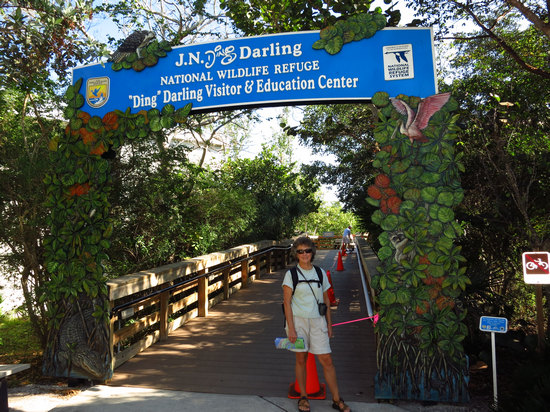
Here we are at the nicely embellished entrance to the visitors center of the J. N. "Ding" Darling National Wildlife Refuge.
Note the safety cones. The metal railing was being prepped and painted by volunteers. Most of the staff inside were volunteers as well.
I think this is pathetic. Can you imagine the IRS, DOD, MSHA or the TSA having to rely on unpaid volunteers to get their mission accomplished? Apparently if it involves outdoor recreation and nature education it is OK to reduce funding to such a level the NPS, NFS and FWS have to rely on an army of volunteers to provide the services for which we paid.
I say again - pathetic!
Never having been here before we stopped in to get maps, etc. The volunteer behind the counter (a retired lawyer) talked to us for about 20 minutes about where to go and what to do. He was quite thorough.
If you ever get to Ding Darling be sure you check out the visitors center. They have tons of great displays and literature along with a photo gallery and dozens of gorgeous hand carved water birds on display.
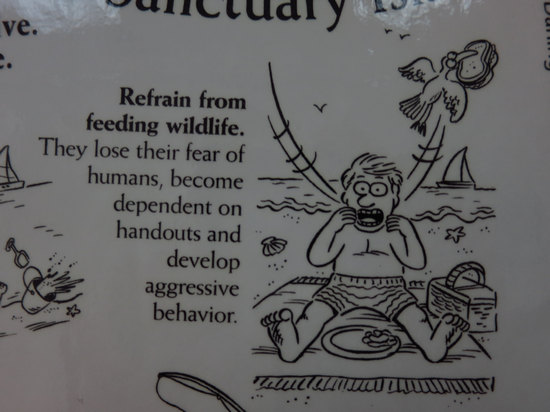
This was part of a poster on the men's room wall. Good advice.
Who exactly was Ding Darling and were did he get that funny nickname?
Read on...
Jay Norwood "Ding" Darling
(1876-1962)
Jay Darling was born in Norwood, Michigan, and spent most of his boyhood on the edge of the American frontier in Sioux City, Iowa. Childhood days were spent exploring the expansive prairies of Nebraska and South Dakota and the banks of the Missouri River where his lifelong devotion to conservation began. As soon as he was old enough, Darling hired himself out to herd cattle across the South Dakota plains.College began badly for Darling when he and some friends "borrowed" the president's horse and buggy for an evening of revelry. He was dismissed from Yankton College in South Dakota in 1894 and began again at Beloit College in Wisconsin the following year. Darling planned to study medicine, the natural outgrowth of his interest in biological systems. Although he applied himself in the life sciences, his major focus at Beloit became his job as art editor for the college yearbook. Darling's irreverent cartoons of Beloit's faculty earned him another suspension, but he returned for his senior year and graduated in 1900. In spite of his escapades, Darling was forever influenced by his biology professor who taught him to view the world as a complete system and always frame it in ecological terms.
Darling accepted a job with the Sioux City Journal in order to save money to enter medical school. It was there, however, that his career as a political cartoonist blossomed, beginning with a story he ran accompanied by a sketch of the story's character - a local recalcitrant attorney who refused to have his photograph taken for the piece.
Darling took the pen name "Ding" to accompany his cartoons and by 1917 was syndicated across the country through the New York Herald Tribune. Eventually Darling's political cartoons would appear in 130 daily newspapers.
Source: US Fish and Wildlife Service
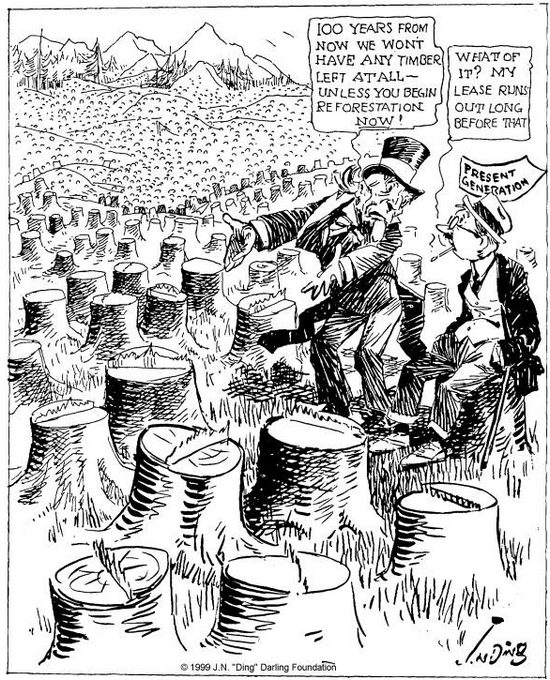
Speaking of our wasteful land and tenantry system:
"100 years from now we won't have any timber left at all--- unless you begin reforestation now; what of it-- my lease runs out long before that; present generation." 1921-04-10
The nickname "Ding"? It was derived by combining the first initial of his last name with the last three letters. Simple, but memorable.
The following info fleshes out Darling's pivotal roll in both wildlife conservation generally and his involvement in what is now Ding Darling NWR
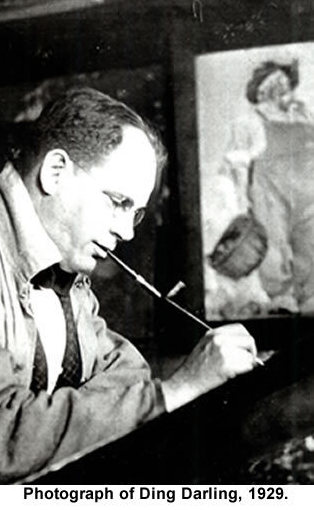
Mr. Darling Goes to Washington
In July 1934, President Franklin Roosevelt asked Darling to head the U.S. Biological Survey, the forerunner of the U.S Fish and Wildlife Service. In this capacity, Darling battled for greater national attention and expenditures for conservation. Darling was responsible for securing some $17 million for wildlife habitat restoration. He established the Migratory Bird Conservation Commission and made great strides toward bringing hunter and conservationist together. He also pioneered leadership in the field of proper game management.First Duck Stamp
Darling initiated the Federal Duck Stamp Program, which uses the proceeds from the sale of duck hunting stamps to purchase wetlands for waterfowl habitat. In fact he drew the first Duck Stamp. Largely responsible for the establishment of the network of game refuges in the country today, Darling was called "the best friend ducks ever had." He liked to remind overzealous developers that ducks can't lay eggs on picket fences.J.N. "Ding" Darling National Wildlife Refuge
For many years, Darling had a winter home in Florida on Captiva Island. Through the efforts of his island neighbors and the J.N. "Ding" Darling Foundation, a refuge was created on Sanibel Island from land donated by concerned citizens and land acquired by the federal government. Administered by the U.S. Fish and Wildlife Service, the Sanibel National Wildlife Refuge has protected habitat for wildlife since 1945. It was renamed in Jay Norwood Darling's honor and officially dedicated to him in 1978.Source: "Ding" Darling Wildlife Society
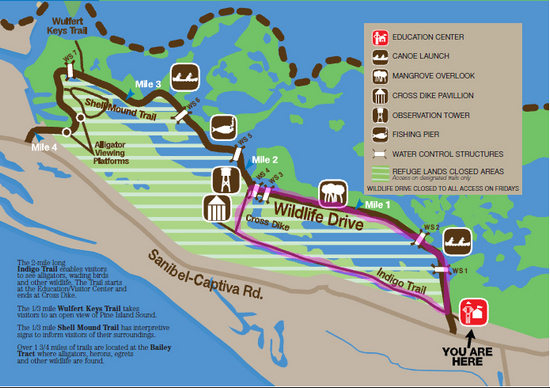
The purple line shows our approximately 4.5 mile walk. The thin line is the Indigo Trail, a crushed shell trail. The thick line is the driving route. We saw only one person on the walking route. We saw many people driving their cars.

A great example of a strangler fig in action.
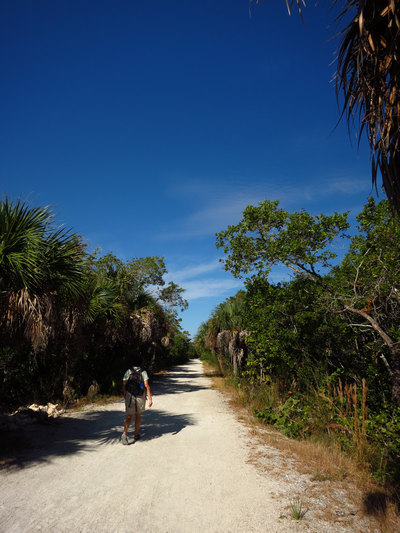
This is looking down the Indigo Trail. There was not a lot to see as far as wildlife and the trail was actually rather monotonous.
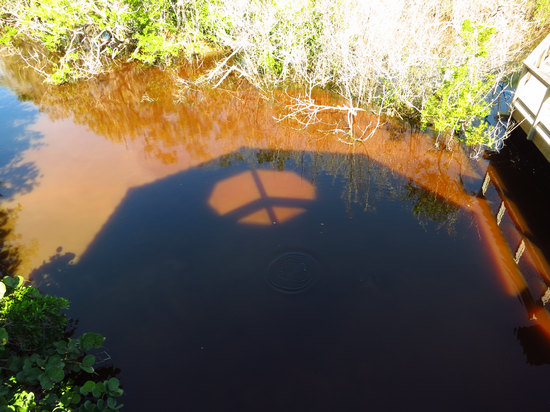
Peace!
This was a shadow of the vent in an elevated observation platform.
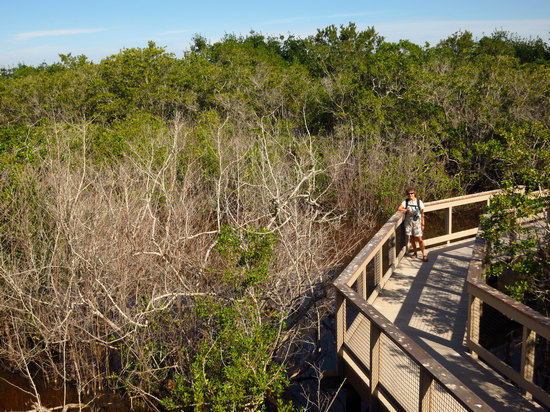
Miss Winky as seen from the observation platform. The board walk went to a locked gate which went to the Sanibel School (K-8).
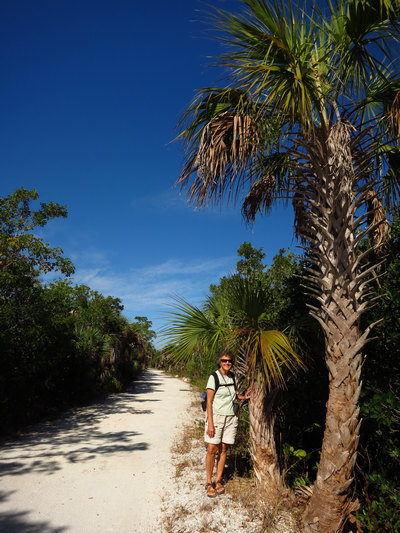
The trail was lined with a dense thicket of mangrove and palms.
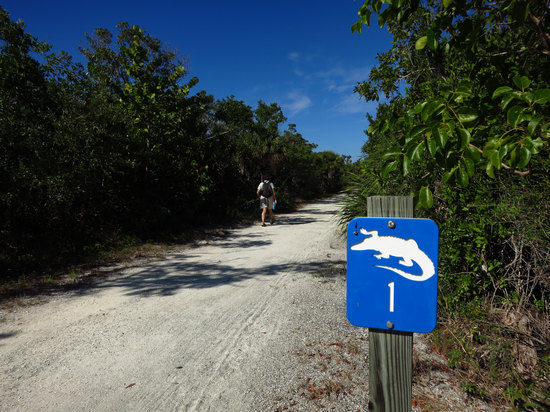
Cool way to embellish a mile marker. We saw no 'gators.

If you look closely you can see some gar in the lower left of the photo. These were about a foot long. But they do get much longer.
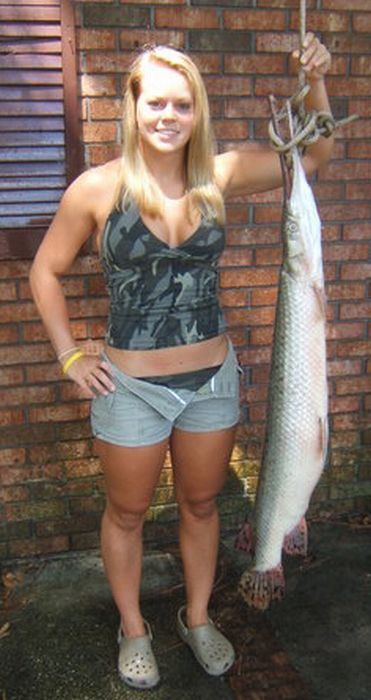
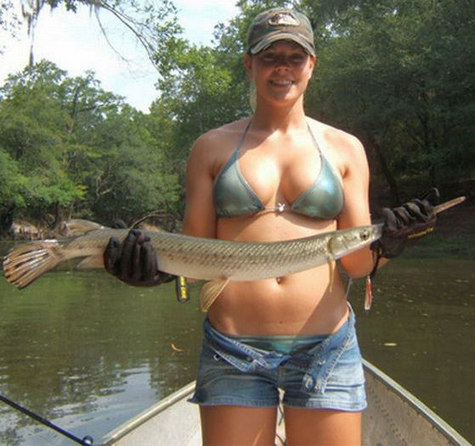
In 2006 when I paddled the Ichetucknee Springs run I saw gar about the size of the one above. It was the first time I had ever seen one. I thought I was seeing some kind of mutant fish.
The gars are members of the Lepisosteiformes (or Semionotiformes), an ancient order of "primitive" ray-finned fish; fossils from this order are known from the late Cretaceous onwards. Fossil gars are found in Europe, India, South America, and North America, indicating that in times past, these fish had a wider distribution than they do today.
Gars are considered to be a remnant of a group of rather primitive bony fish that flourished in the Mesozoic, and are most closely related to the bowfin, another archaic fish now found only in North America. The many species of gar include the alligator gar, which can exceed ten feet in length.
Source: WikiPedia
And that ends our rather superficial tour of Ding Darling NWR. Next time I hope we get to spend more time there.
Afterwards we went back to beach and beer and whiled away the rest of the day in a most lazy fashion.
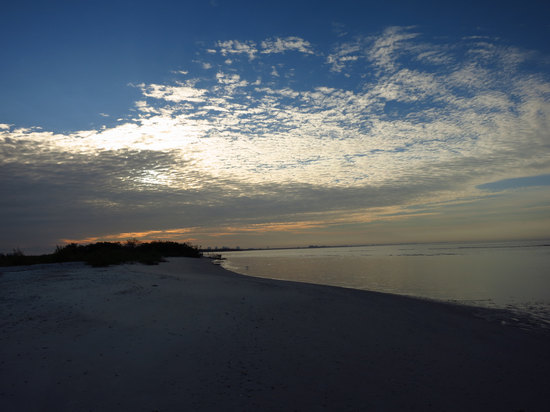
Another lovely day break at the beach. We would only have one more of these before we would have to start the drive home.

I could not resist taking a few more shots of the Reddish egret. Beautiful bird!
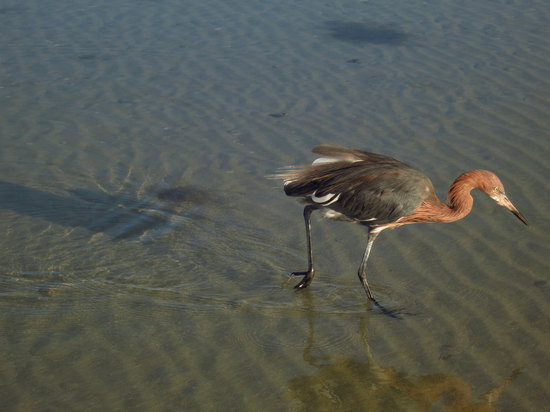
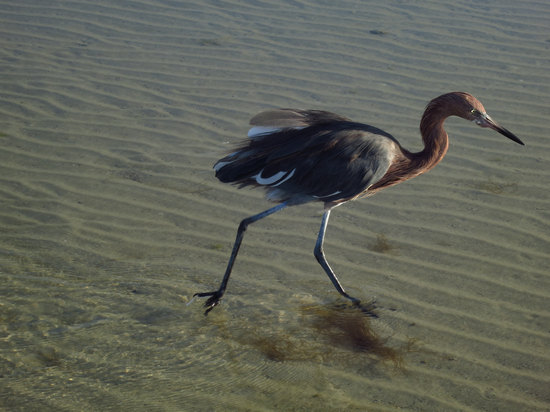
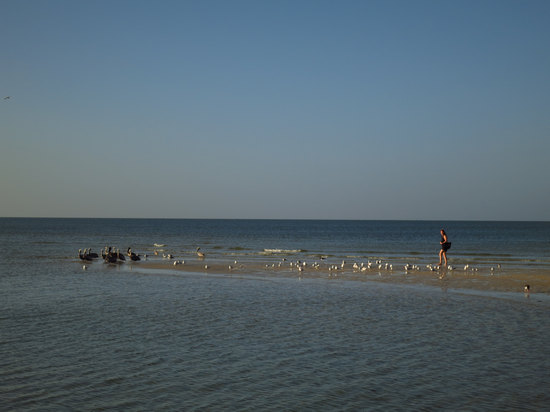
At low tide there are numerous sand bars which are enjoyed by both birds and humans.
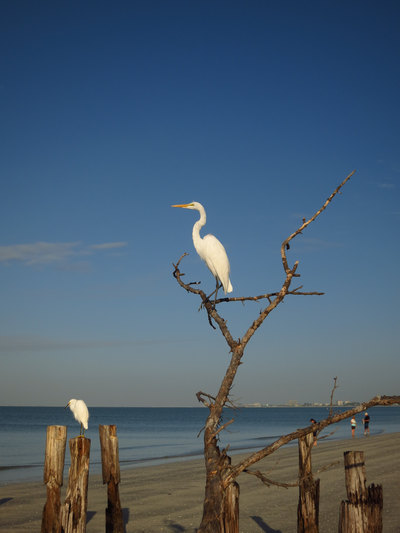
Great Egrets
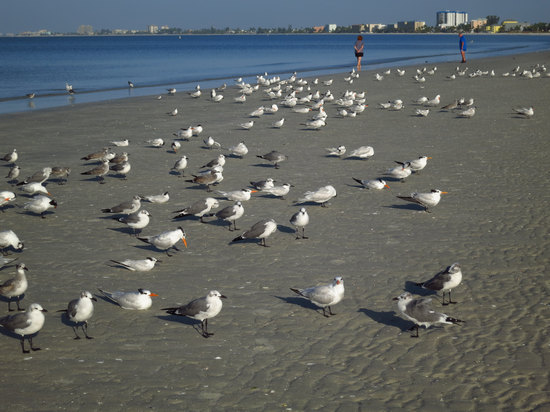
Royal terns, Black skimmers and Laughing gulls. It was really fun to be able to get this close to them.
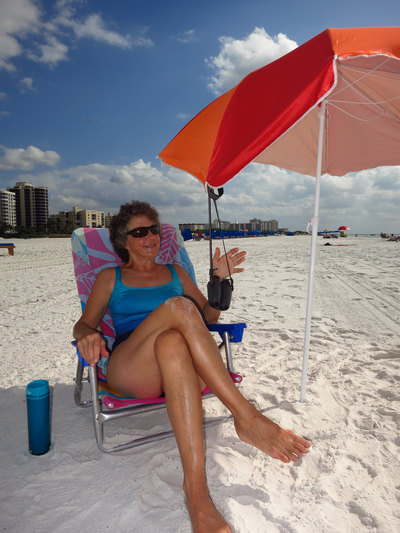
The ever ready bird watcher!
Actually, Betsy used her binocs to weight down the umbrella which kept getting lifted and folder over by the wind. Clever girl...
That night we went to Flippers On The Bay for our fancy dinner out. We sat on the deck pictured below. The photo is from Flippers' web site.
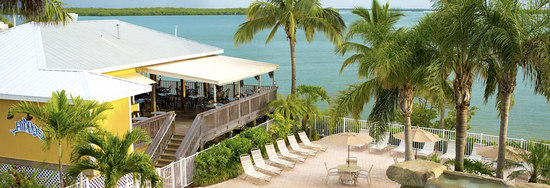
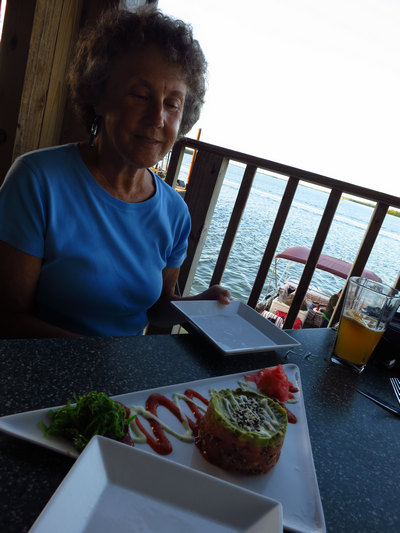
For our appetizer Betsy ordered tuna ceviche - fresh yellow fin tuna with pickled ginger, diced cucumber and avocado relish tossed with sesame seeds, lemon juice, & house made cusabi & asian garlic sauces.
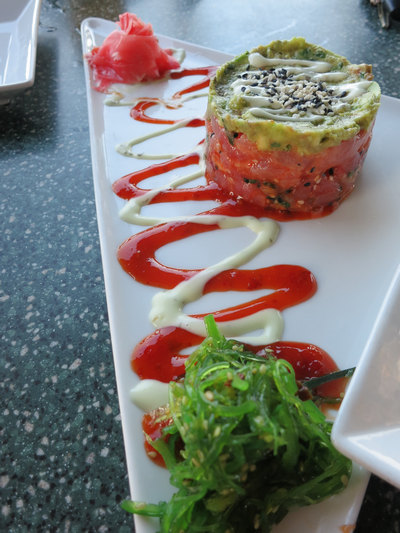
Tasty!
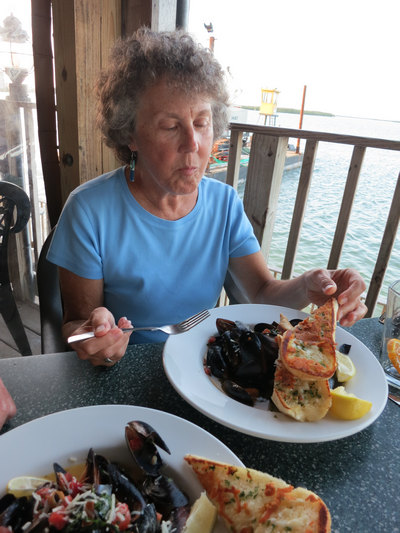
All of the appetizers were half off so next we both got an order of the fresh black cold water mussels sautéed with garlic, white wine, lemon butter, tomato, fresh parsley and served with toast points. Mmm, mmm good! We used the toast points to sop up as much of the broth as we could.
To top off my meal I had the Asian chicken salad - marinated grilled chicken breast tossed with Napa cabbage, sliced red onion, bell pepper, crispy wonton, bean sprout, cilantro and greens in a house made plum vinaigrette.

The grand finale! Betsy rarely indulges in dessert but I talked her into it. She ordered the Key Lime Coolada - house made Pina Coolada, KeKe Key Lime Liqueur and rum blended then gently poured into a glass rimmed with graham cracker.
A very nice dinner, right on the water. Perfect for our last supper here.
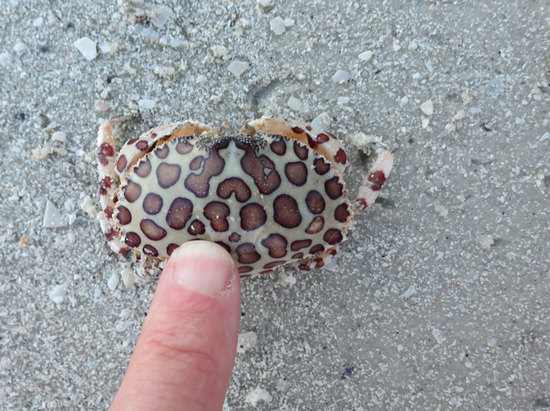
The next morning, our last one, we saw this beautiful Calico Box Crab. Neither of us had ever seen one before.
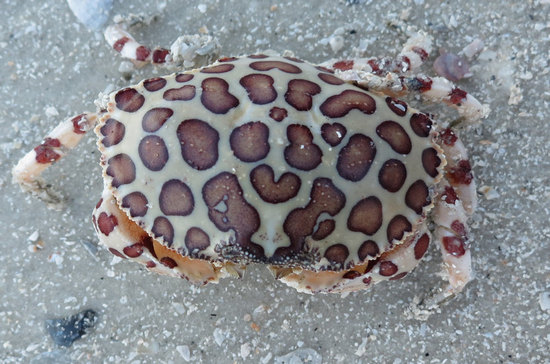
Calico crabs are scavengers, not hunters, and they feed on the detritus (decomposing organic matter from plants and animals), serving in the diverse "garbage disposal" community of the ocean. Fishermen use the Calico box crab as live bait for saltwater fishing, and, as a crab, it is also a major part of the Kemp’s ridley sea turtle diet.
Source: National Park Service
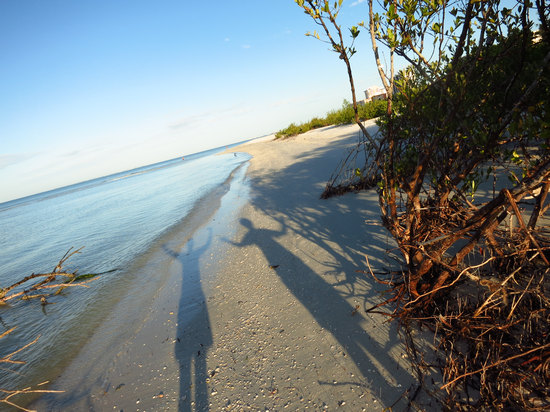
The last shot of out nice trip to the beach - the two beach bums basking in the early morning sun.
Until next time...
Mike and Betsy
Betsy's Bird List
- Great blue heron
- Turkey vulture
- Black vulture
- Brown pelican
- Black skimmer
- Great egret
- Snowy egret
- Mocking bird
- Sanderling
- Ruddy turnstone
- Willet
- Double crested cormorant
- Royal tern
- Sandwich tern
- Magnificent Frigate Bird
- Reddish egret
- White ibis
- Osprey
- Tricolored heron
- Boat tailed grackle
- Fish crow
- Red bellied woodpecker
- Ground dove
- Morning dove
- Kingfisher
- Phoebe
- Cardinal
- Roseate spoonbill
- White pelican
- Woodstork
- Little blue heron
- Anhinga
- Bald eagle
- Semipalmated plover
- Forsters Tern
- Oyster Catcher